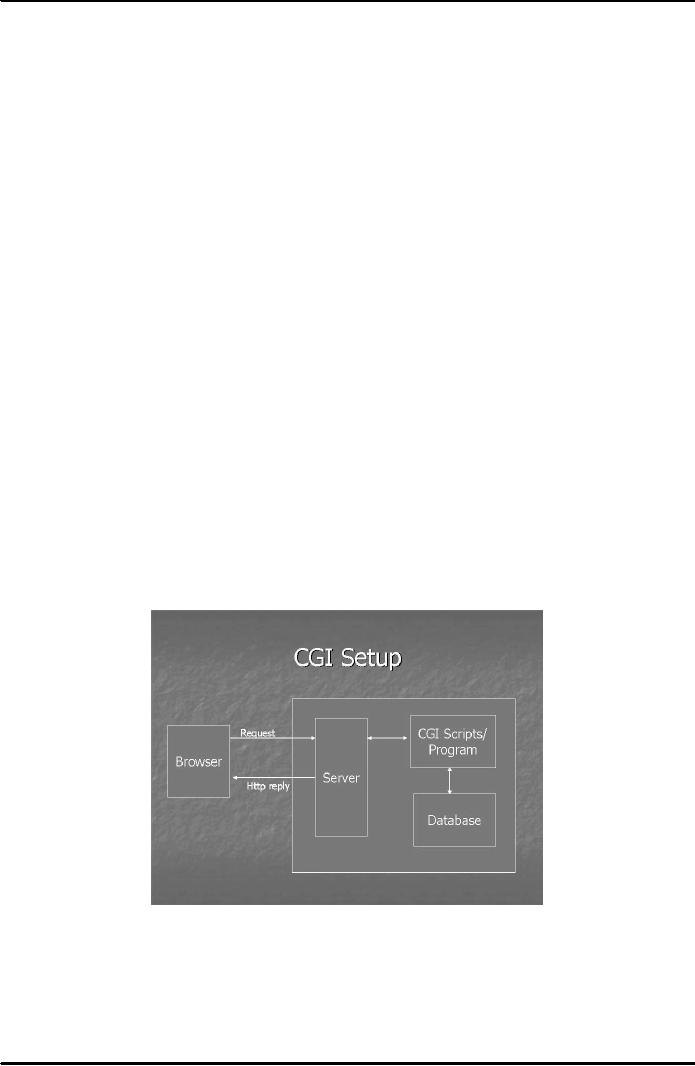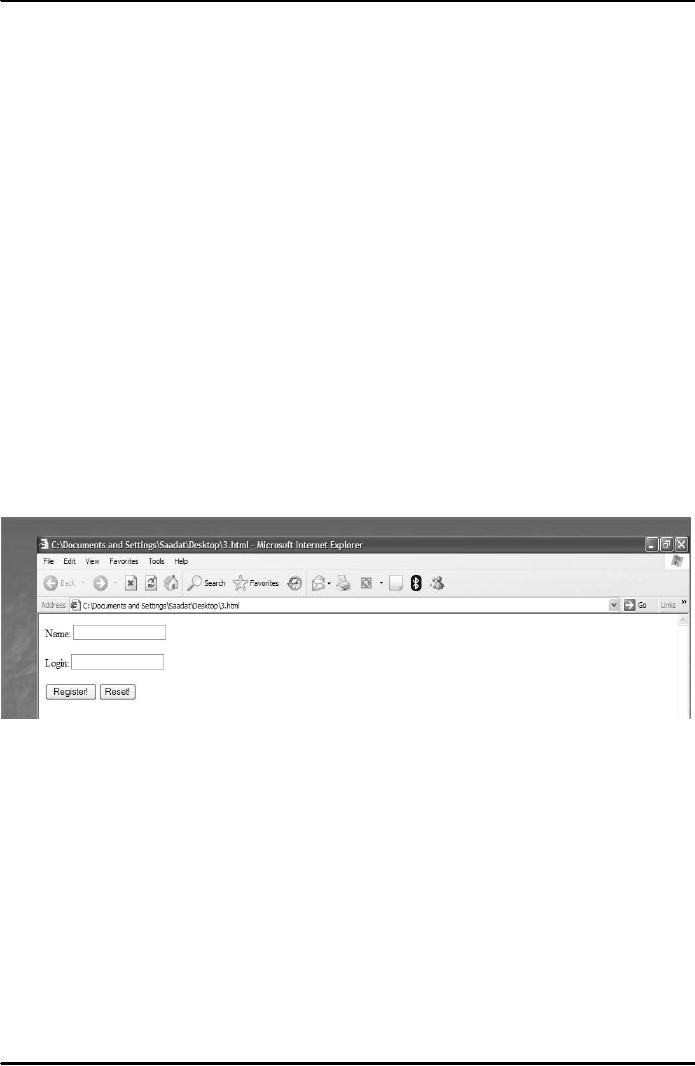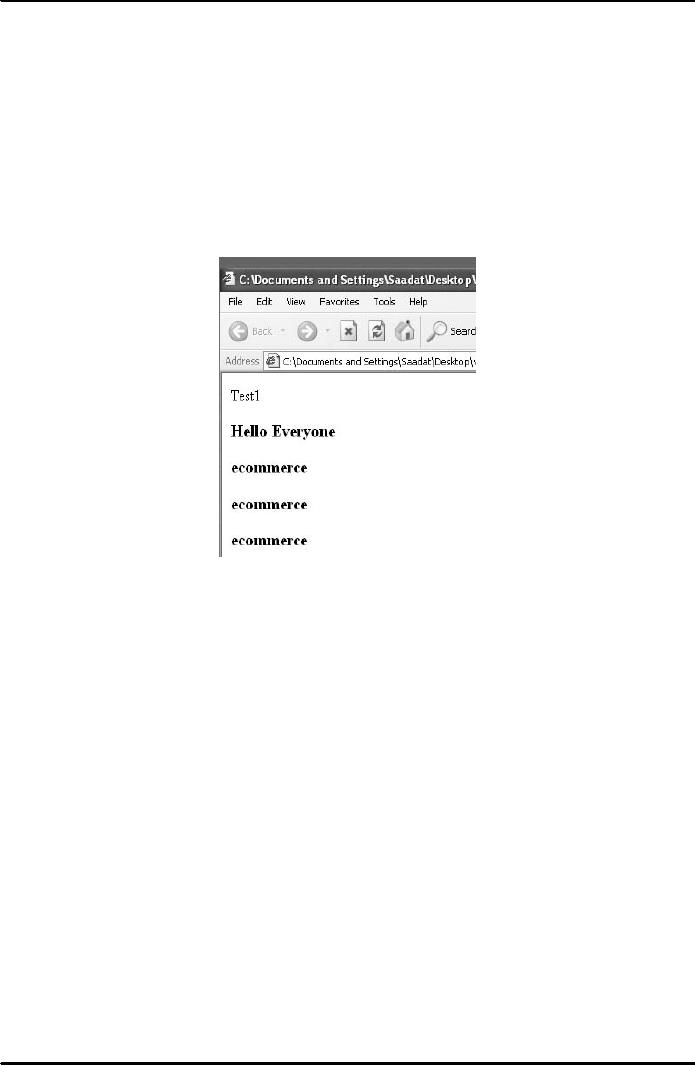 |
APPLETS, CGI SCRIPTS |
| << CLIENT AND SERVER SIDE PROCESSING OF DATA |
| MAINTAINING STATE IN A STATELESS SYSTEM >> |

E-COMMERCE
IT430
VU
Lesson
18
APPLETS,
CGI SCRIPTS
You
know that Web Server is a
computer that delivers (serves
up) web pages. Any computer
can be turned
into a
Web server by installing
server software and connecting the
machine to the internet. A
relational
database
or simply database is a collection of
information stored in tables. A
database contains one or
more
tables.
Each table has a name and
consists of columns and
rows. Each column has a
name. Most e-
commerce
sites consist of a front end
and a back end. Front
end consists of that
information which is
visible to the
user and he can interact
with the same through some
interface. The back end
comprises that
information
which resides on the server
side and is used to create
certain dynamic results for
the user. It
would
include different programs or scripts
that may be developed in different
languages/tools. For an
effective
e-commerce site there must
be a real integration or compatibility
between the front end and
the
back
end. We develop our back end
mainly for two purposes
for querying with the databases
(where we
have
developed databases) and for the
maintenance of state. We can
use different tools (ASP,
JSP etc.) for
that
purpose depending upon their
respective advantages/disadvantages.
Server side processing can
be
mainly
categorized into four
headings -CGI Scripts,
Servlets, Server Side
Scripts and JDBC/ODBC
drivers.
CGI
scripts
Term Common
Gateway Interface (CGI) is
defined as a standard method/protocol
that allows data
from
forms to be
used by programs on the server.
Script is a program running on the
server. CGI scripts
include
programs
written in C, C++ or perl. Following
Figure 1 shows a simple CGI
setup. Suppose a client
makes
an
http request by clicking a hyperlink.
This request is directed to a
CGI script on the server
side whose
reference
would be given in the <A> tag. The
server would communicate
with the CGI script on it
with the
help
of CGI protocol. The script
would be executed. We would do
its coding such that it
generates a query
to the
database to retrieve specific
information. This information would
then be supplied by the server to
the
client side as an HTML document.
You can also consider an
example. Assume there are
two links on a
web
page (Fig. 2). When the user
clicks on the hyperlink pertaining to IT
Books, an http request goes
to the
server
at the address, which is shown as value
of the href attribute of the anchor
tag. This address is that
of
a CGI
script `hello2.cgi', which is
coded in such a way that it
would generate a select
query in SQL and from
the table IT books
would retrieve all the information as a
result for the user. The
Perl code of hello2.cgi is
shown
for a reference below.
Fig.
1
82

E-COMMERCE
IT430
VU
Fig.
2
Code
for Fig. 2
<HTML>
<BODY>
<A
href=http://www.onlineshop.com/cgi-bin/hello1.cgi>
Click
here to view the record of
your previous transactions
</A>
<p>
<A
href=http://www.onlineshop.com/cgi-bin/hello2.cgi>
List
of IT Books for sale
</A>
</BODY>
</HTML>
Perl
example hello2.cgi (Not for
exam)
print
"<head>\n";
print
"</head>\n";
print
<body>\n";
print
"<h1>IT Books</h1>\n";
print
"<b>Description of available
books</b><br>";
&SetOracle;
&RunSQL("Select
* from ITBOOKS");
&StopOracle;
print
"</body></html>\n";
Structured
Query Language (SQL)
SQL
stands for Structured Query
Language. It is used to make
queries from databases. Its
syntax may vary
slightly
from tool to tool. However,
its general syntax is that
we use select statement to retrieve
data from
databases.
We use "*" after the word select
then write the words "from
tablename" in order to pick the
entire
information from a table. We
can write the select
statement specifically in case
some specific
information
is desired to be retrieved as shown
below:
Select
author,publisher from ITBOOKS where
coursename=`e-commerce'
We can
use insert statement of SQL in
order to insert certain data
in a database. For example in Fig.
3
below,
you can see a web form
with text boxes. When a
user clicks at the Register!
button (in fact a submit
button),
information provided by the user in the
form would be shipped to the
URL specified as value
of
the action
attribute in the form tag.
Here, that URL is that of an
ASP file running on the
server side. On
clicking the
Register!/submit button this file would
be executed. We would code it
such that it gives rise
to
an
insert query. In other
words, data provided in the
form is picked up by the ASP file
and subsequently
inserted
or recorded in a table in the databases.
The format of Insert query
used in ASP is shown for
a
reference
below. We may also use
delete and update statements
in SQL for deleting and updating
data in the
tables.
83

E-COMMERCE
IT430
VU
Fig.
3
Code
for Fig. 3
<HTML>
<BODY>
<H3>To
Register Please Enter The
Following Information:</H3>
<FORM
NAME="regForm"
ACTION="http://www.onlineshop.com/hello.asp"
METHOD="POST">
Name:
<INPUT TYPE="TEXT" NAME="Name"
maxlength="25">
<P>
Address:
<INPUT TYPE="TEXT" NAME="userAdd"
maxlength="50">
<P>
Password:
<INPUT TYPE="Password"
NAME="userPassword"
maxlength="15">
<P>
Email:
<INPUT TYPE="TEXT" NAME="email"
maxlength="15">
<P>
<INPUT
TYPE="submit" NAME="Go"
VALUE="Register!">
<INPUT
TYPE="RESET" VALUE="Reset!">
</FORM>
</BODY>
</HTML>
Insert
Statement in ASP (not for
exam)
INSERT
INTO Register(Name,Address,Password,Email)
VALUES(Request.form("Name"),
Request.form("Address"),
Request.form("Password"),
Request.form("Email"))
Register
is the table where information received
through the form is to be
inserted.
Servlets
Servlets
are very fast Java applications on the
server side which are
available in an active form in
the
memory
of the server. They use JDBC to connect
to the databases.
Server
Side Scripts
They
basically include ASP, JSP or PHP.
Active Server Pages (ASP) is
the product of Microsoft, Java
Server
Pages
(JSP) is the product of Sun
Microsystems and Hypertext
Preprocessor (PHP) is the product
of
Apache
Software Foundation. Their
code can be embedded within
the HTML document and they use
extensions
(.asp), (.jsp) or (.php), as the case
may be. The servers
sees the extension of the file and
processes
84

E-COMMERCE
IT430
VU
the relevant
ASP, JSP or PHP code
embedded within the HTML code
and provides the result of such
code
to the
client side.
ODBC/JDBC
ODBC
(Open database connectivity)
and JDBC (Java based
database connectivity) drivers are
also present
on the
server side. Scripts or
programs use these to
establish connection with databases
for querying.
Basic
difference between CGI
scripts, ASPs, Servlets
etc.
Here,
you can note some
basic difference between CGI
scripts, servlets, ASP, JSP
etc. We know that the
code
we write is translated into an
executable form. There are
two ways to do this translation. One is
that
we compile the
code or convert it into machine
language using a software
called compiler, as we use in
case
of C or
C++. The other way is
that we interpret the code
(line by line) at the run time
using a program
called
interpreter. Browser is an interpreter. Compiled code
is usually faster than the
interpreted one as
regards
execution. Technologies like ASP,
PHP and Coldfusion interpret
their code except the new
version
of ASP
(ASP.net) where the code is compiled. In
case of JSP a program called JSP engine
compiles the
code.
This compilation takes place
only once, and then the JSP
page is converted into a Servlet.
The
property
of a servlet is that it is always in an
active form which means
that it remains in the server
memory.
Therefore,
any subsequent calls to the
page have faster response
time. This probably is the only
main
difference
between a JSP and a Servlet.
Another difference between ASP
and JSP is that ASP mostly
uses
VBScript
and JSP uses Java programming
language for coding. Note
that among the CGI scripts,
Perl
scripts
are interpreted and C++
scripts are compiled. However,
CGI scripts are generally
believed to be
relatively
slow, since each CGI
request generates a new
process which is heavy for
the system. Therefore,
CGI
scripts are no longer a very popular
option.
ASP
We can
discuss ASP a little more in
detail. It runs best on IIS
(Internet Information Server)
which is freely
available
with Windows NT and Windows
2000. ASP engine is a piece
of software that is a part of
IIS and
interprets/translates
an ASP code. There are mainly
seven predefined objects in ASP
called intrinsic
objects.
To
have some idea of the ASP
objects, we can have a look
at the two important ones,
that is, request
and
response
objects. Response
object is
used to send information to the
client and Request object is
used by the server to
retrieve
information from the client.
ASP
examples (not for
exam)
Following
is the example of Response object. We use
its "write" function to
write some
information
on our web page. ASP
normally uses VBScript as the scripting
language. In
ASP, a
variable is generally defined using
Dim statement as shown in the
code below.
ASP
statements are contained within <%
and %> which are called
delimiters. VBScript by
default
assumes that any symbol
that is not a keyword is a
variable. This might cause
serious
problems
when you are writing an ASP
application. What if you mistype a
variable name and
it
will be considered by the server as a
new variable. To avoid this
you must write
Option
Explicit
at top of your each ASP
file.
<%@
language=VBScript %>
<%option
explicit%>
<%Dim
lastname
Dim
firstname
Dim
myage
lastname="Ali"
firstname="Imran"
myage=30
%>
85

E-COMMERCE
IT430
VU
<html>
<head><title>It
is easy</title></head>
<body>
My
name is <%=firstname%>
<%=lastname%> and my age is
<%Response.Write
myage%>
</body>
</html>
Suppose
that we want to collect data from a
form (Fig. 4) using ASP and
then resend a page
to the
client having that information
written on it. For that
one can develop the
following
ASP
code. Note the use of
"Request.form" for collecting data
form the form.
<%@Language="VBSCRIPT"%>
<%option
explicit%>
<%Dim
loginname
Dim
name
loginname=Request.Form("userlogin")
name=Request.Form("username")
%>
<html>
<head><title>It
is easy</title></head>
<body>
My
name is <%Response.Write name%> and
I am going to use
<%Response.Write
loginname%> as my login
</body>
</html>
Fig.
4
When a
user clicks at Register! the
information filled by him in the
above two boxes
would
be delivered to the
ASP file whose code
you have seen above.
This would happen
because
we
keep the name or URL of the
above ASP file as value of
the action attribute in the form
tag.
VBScript
offers a lot of flexibility for
programming. We can use functions, If
statements,
For
loops etc. Consider the following
example where a For loop
has been used:
<%@Language="VBSCRIPT"%>
<%option
explicit%>
<HTML>
<Body>
Test1
<%
Dim
myString="ecommerce"
%>
86

E-COMMERCE
IT430
VU
<%If
Time>=#12:00 AM# and Time<=#12:00
PM# then%>
<h3>Good
Morning Pakistan</h3>
<%else%>
<h3>Hello
Everyone <p>
<%
Dim
j
For
j=1 to 3
Response.write
mystring
response.write
"<p>" Next %></h3> <%
end if %> </Body> </HTML>
Result of the above
code
would
be similar to the one shown in Fig. 5
below. Note that the words
ecommerce are printed thrice
due
to for
loop written in a specified
format in VBScript.
Fig.
5
87
Table of Contents:
- E-COMMERCE
- WHAT IS A NETWORK
- HOW MANY CLASS A, B, C NETWORKS AND HOSTS ARE POSSIBLE
- NETWORKING DEVICES
- BASICS OF HTML 1
- BASICS OF HTML 2
- TEXT BOXES, CHECK BOXES, RADIO BUTTONS
- FRAMES AND IMAGES IN HTML
- TAG ATTRIBUTES, SOUNDS FILES, ANIMATIONS
- STYLE SHEETS 1
- STYLE SHEETS 2
- SOME USEFUL STYLE SHEETS PROPERTIES
- JAVA SCRIPTING 1
- JAVA SCRIPTING 2
- JAVA SCRIPTING 3
- JAVA SCRIPTING AND XML
- CLIENT AND SERVER SIDE PROCESSING OF DATA
- APPLETS, CGI SCRIPTS
- MAINTAINING STATE IN A STATELESS SYSTEM
- INTEGRATION WITH ERP SYSTEMS
- FIREWALLS
- CRYPTOGRAPHY
- HASH FUNCTION AND MESSAGE DIGEST
- SYMMETRIC KEY ALGORITHMS
- VIRTUAL PIN PAYMENT SYSTEM
- E-CASH PAYMENT SYSTEM 1
- E-CASH PAYMENT SYSTEM 2
- SECURE SOCKET LAYER (SSL)
- E-BUSINESS: DISADVANTAGES OF E-BUSINESS
- E-BUSINESS REVENUE MODELS
- E-MAIL MARKETING
- CUSTOMER RELATIONSHIP MANAGEMENT (CRM)
- META INFORMATION
- DATA MINING
- CONFIDENCE AND SUPPORT
- ELECTRONIC DATA INTERCHANGE (EDI)
- PERSONAL FINANCE ONLINE
- SUPPLY CHAIN
- PORTER’S MODEL OF COMPETITIVE RIVALRY
- BARRIERS TO INTERNATIONAL E-COMMERCE
- ELECTRONIC TRANSACTIONS ORDINANCE, 2002 - 1
- ELECTRONIC TRANSACTIONS ORDINANCE, 2002 - 2
- ELECTRONIC TRANSACTIONS ORDINANCE, 2002 - 3
- GLOBAL LEGAL ISSUES OF E-COMMERCE - 1
- GLOBAL LEGAL ISSUES OF E-COMMERCE - 2